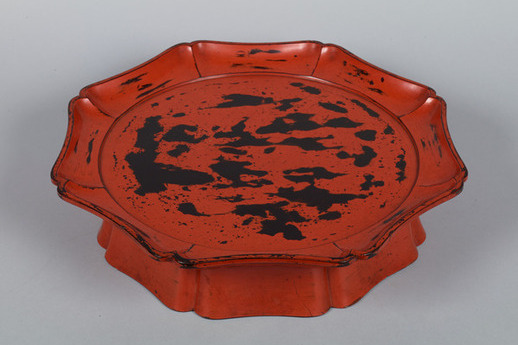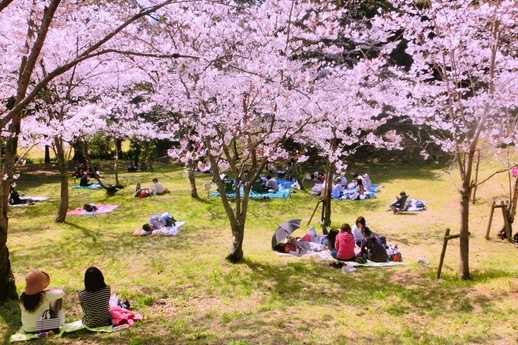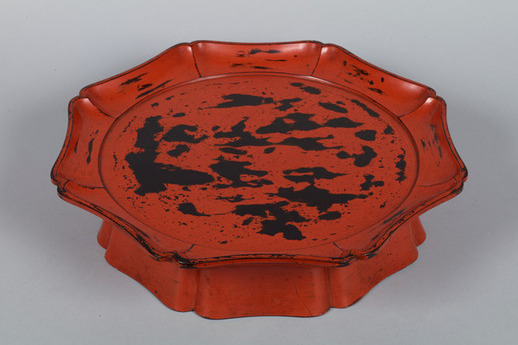2025.03.27
伝検通信(メルマガ)週刊メールマガジン「伝検通信」 第51号
週刊メールマガジン「伝検通信」第51号をお届けします。
今週のトップ記事は、白洲信哉さん「多様なるジャパン」 の連載第5回、経年変化の日本美を伝える漆をめぐる話題です。
「クイズで肩慣らし」は、前回クイズの答え・解説と、芸能分野の問題です。
新規メルマガ登録者に、伝検公式テキストを抽選で50名に進呈す
第2回伝検は6月1日から実施します。申し込みは5月1日開始です。公式テキスト、オンライン講座を活用して、ぜひご準備ください。
伝検公式教材・参考書・サイト https://denken-test.jp/
目次
・ 「多様なるジャパン」 第5回 根来
・ 「クイズで肩慣らし」 第50回=「芸能」
・ 伝検協会だより
「多様なるジャパン」 第5回 根来
白洲信哉=文筆家、日本伝統文化検定協会副会長

朱漆輪花盤(室町時代・16世紀)東京国立博物館所蔵
出典:ColBase(https://colbase.
字引を引くと、「磁器」をChinaと呼び、Japanは、「漆器」とあり、温暖多湿なモンスーン気候帯のみに植生する漆は、手先の器用な日本人が育んだ天然素材である。縄文時代には土器の補修や鏃(やじり)を矢柄に取り付ける接着剤として、精製技術を会得すると塗料に進化、世界最古1万2600年前、縄文早期の遺跡から朱漆の櫛(鳥浜貝塚)も出土、まさしく「漆の国」なのだ。中でも僕は黒漆に朱漆を重ねた「根来(ねごろ)」を賞翫(しょうがん)する。これこそが経年変化の日本美を如実に伝え、手仕事ニッポンの実用的な機能のみならず、呪術的象徴でもあるからだ。
根来は、積年の使用具合により上塗りの朱色がはげ、下塗りである黒色の塗り肌が出てくることにより、自然に出来上がった抽象文様をいう。従って、作品全てオンリーワン、時が育んだ「美」なのである。世界のスタンダードははげたら塗り直すと思うが、僕らは古色を尊び、そのはげ具合に一喜一憂、好みの分かれ目である。
漆の赤色には酸化第二鉄を使ったベンガラと酸化水銀を使った水銀朱があるが、後者は「黄金千杯、朱千杯」といわれ、かつて金に匹敵する重要鉱物として宝物のように扱われ、不思議な霊力を持つカミとして崇められた。鉱脈のある所を「丹生(にう)」と言い、百を超える丹生神社の半数は根来の語源である根来寺のある和歌山県に集中、元締めは紀ノ川沿い対岸の丹生都比売(にうつひめ)神社だ。弘法大師空海が高野山を開いたのは、狩場明神(かりばみょうじん)という縄文のカミ様のお導きとされているが、大師は丹生の鉱脈利権に目を付け、丹生の女神を高野山に招来したのである。
貴重な朱は貴族や宮中の器物として、新嘗祭(にいなめさい)の食器は三位以上が朱漆の使用を許されるなど上位の者しか使えなかった。黒漆にわざわざ朱漆を重ねて塗ったのは、強度や耐水耐火性を高めるだけでなく、先の櫛や縄文土器に古墳の石棺など赤く装飾したと同様に、死者の蘇り(よみがえり)や魔除け(まよけ)など僕らのDNAに刷り込まれたさまざまな霊的願いがこもった原始の色だったからだ。
さらに大事なことは塗料である漆の縁の下の力持ち「木地(きじ)」だ。家作りと同じく土台がしっかりしていないと、外見の朱色がいくら魅力的でも長年の使用に耐えられない。強靭(きょうじん)な木地造りこそが使い易さに耐久性、機能性を加えた「用の美」の根幹で、時のつくった「美」根来の本質なのだ。ちなみに「根来に根来なし」と言われるように「根来」は中世より伝来した堅牢で優れた朱漆器全般の総称で、その技術が伝播した輪島塗のような産地名でなく、昨今、海外では「NEGORO」で通っている。
「クイズで肩慣らし」 第50回=「芸能」
~伝検公式テキスト(好評発売中)の分野ごとに出題します~

キツネには神通力があり、「義経千本桜」では人に化けて現れるとされた(写真は生成AI画像)
第50回
問題:白地に絹糸を房飾りのように縫い付け、「義経千本桜」の源九郎狐などキツネの化身を表す歌舞伎の衣装の名前は何でしょうか。(答えと解説は次号で)

春は花見の季節、食事を伴う現代の形になったのは安土桃山時代から
【前回の問題と答え・解説】
問題:花見は、もともと平安貴族が桜の花を見ながら、歌を詠んだり蹴鞠(けまり)をしたりする行事でした。その後、安土桃山時代から、今のような酒宴を伴う形に変わったと言われています。そのきっかけとなった、有名な花見を何というでしょうか。
答え:醍醐の花見
解説:醍醐の花見は、豊臣秀吉が慶長3年(1598)の春に京都の醍醐寺近くの山で開催した盛大な花見です。700本を植樹して約1300人が参加したという秀吉一世一代の催し物で、歌舞伎の演目になったり、「豊太閤花見行列」というイベントが開催されたりしています。ピンク、白、緑の三色団子も醍醐の花見から始まったという説もあります。花見を一般に広めたのは、徳川幕府の8代将軍である徳川吉宗の功績が大きいといわれています。
伝検協会だより
週刊メールマガジン「伝検通信」が今週で1周年を迎えました。この1年、日本全国に息づく伝統文化・伝統産業の価値を少しでも知っていただき、楽しく学んでいただけるよう、さまざまなコンテンツをお届けしてきました。読者の皆さまからはたくさんのご意見をお寄せいただいており、この場を借りて感謝申し上げます。
2年目も白洲信哉氏の「多様なるジャパン」、近藤宙時氏の「宙ちゃんの伝統文化一直線」などのコラムや、問題形式の「クイズで肩慣らし」を中心にご提供していきます。引き続きご愛読いただき、一人でも多くの方に伝検試験に挑んでいただけることを願っております。また、合格された方には、さらに伝統文化の知識を深めていただく一助になれば幸いです。
【編集後記】
伝検通信第51号をお届けしました。今週後半は七十二候で「桜始開(さくらはじめてひらく)」の期間に当たり、本日は「さくらの日」でもあります。先週末より暖かくなり、伝検協会のある東銀座かいわいでも桜が見頃を迎えつつあります。そろそろ花見の時期ですね。
【English version】
Weekly e-newsletter Denken Tsushin, No. 51.
We are pleased to present the 51st issue of our weekly e-newsletter DENKEN Tsushin.
This week's top article is the fifth in the series of Shinya Shirasu's ‘Diverse Japan’, on the topic of lacquer, which conveys the beauty of Japan as it changes over time.
In the ‘Let's Practice with Quizzes’ section, you will find answers and explanations to the previous quiz, as well as questions on the field of the performing arts.
A campaign is under way to award 50 new newsletter subscribers with a copy of the official DENKEN textbook. The campaign is open from 10 March to 18 May. Please encourage your friends to register for the newsletter.
The second biennial test will take place from 1 June. Registration opens on 1 May. Please use the official textbooks and online courses to prepare yourself.(https://denken-test.jp/info/1795/)
Official Denken teaching materials, reference books and website https://denken-test.jp/official_text/
Table of contents.
・Diverse Japan - Vol. 5: Negoro
・‘Let's Practice with Quizzes’ No. 50 = ’Performing Arts
・From Denken Association
Diverse Japan Vol. 5 Negoro
Shinya Shirasu = writer, vice-president of the Japan Traditional Culture Certification Association

Red lacquer rinka-ban (Muromachi period, 16th century), Tokyo National Museum collection.
Source: ColBase (https://colbase.nich.go.jp/)
The Japanese character dictionary calls porcelain ‘China’ and Japan ‘lacquerware’. Lacquer, which grows only in warm and humid monsoon climates, is a natural material nurtured by the dexterity of the Japanese people. During the Jomon period, lacquer was used to repair earthenware and as an adhesive for attaching arrowheads to arrowheads, and when the technique of refining lacquer was mastered, it evolved into paint. I particularly admire Negoro, which is black lacquer overlaid with vermilion lacquer. This is because it conveys the Japanese beauty of ageing and is not only a practical function of handmade Japanese craftsmanship, but also a magical symbol.
Negoro refers to the abstract patterns that are naturally formed when the vermilion of the top coat peels off and the black of the undercoat appears as a result of years of use. Therefore, every piece is unique, a beauty nurtured by time. The world standard is to repaint when the lacquer peels off, but we respect the old colour and are happy or sad to see it peel off, and our tastes differ.
There are two types of red lacquer: bengara, made from ferric oxide, and mercury vermilion, made from mercury oxide. Half of the more than 100 Niu shrines are concentrated in Wakayama Prefecture, where Negoroji Temple, the origin of the word Negoro, is located, and the Niutsuhime Shrine on the opposite bank of the Kino River is the original centre. It is said that Kobo-Daishi Kukai founded Koyasan under the guidance of a Jomon deity called Karibari Myojin, who, having spotted the mineral rights in Niu, invited the Niutsu no Mikami to Koyasan.
The precious vermilion was used by the nobility and court nobility, and only those of the third rank and above were allowed to use vermilion lacquer for the Niinamesai ceremony. The reason why vermilion lacquer was deliberately applied over black lacquer was not only to increase strength and water and fire resistance, but also because it was the primitive colour of various spiritual wishes imprinted in our DNA, such as reviving the dead and repelling evil spirits, as in the red decoration of combs, Jomon pottery and sarcophagi from ancient burial mounds.
What is even more important is the ‘kiji’, the wood behind the lacquer, which is the paint. Just like building a house, if the foundation is not solid, the wood cannot withstand many years of use, no matter how attractive the vermilion colour may be on the outside. Strong wood construction is the basis of the beauty of use, which adds durability and functionality to ease of use, and is the essence of Negoro, the ‘beauty’ created by time. Incidentally, as the saying goes, ‘Negoro ni negoro nai’ (Negoro has no Negoro), ‘Negoro’ is a general term for all the robust and excellent vermilion lacquerware introduced in the Middle Ages, and is nowadays known overseas as ‘NEGORO’, rather than the name of the production area, like Wajima-nuri, where this technique was transmitted.
‘Let's Practice with Quizzes’ the subject 50 = ‘Performing arts’
~Questions will be asked in each area of the official text of the Biography Test (now on sale).

Foxes have divine powers and in ‘Yoshitsune Senbonzakura’ they were said to appear disguised as people.
Part 50.
Question: what is the name of the Kabuki costume with silk threads sewn like tassels on a white background, representing incarnations of foxes, such as the Genkuro fox in ‘Yoshitsune Senbonzakura’? (Answer and explanation in next issue)

Spring is the season for cherry blossom viewing, which took on its modern form with meals from the Azuchi-Momoyama period.
Previous Question and Answer/Explanation
Question: Hanami was originally an event for Heian aristocrats to recite poems and play kemari (a Japanese game of chess) while viewing cherry blossoms. Later, from the Azuchi-Momoyama period (1568-1600), it is said to have changed to the form with drinking parties as we know it today. What is the name of the famous hanami that led to this?
Answer: hanami in Daigo.
Explanation: Daigo no Hanami was a grand Hanami held by Toyotomi Hideyoshi on a mountain near Daigoji Temple in Kyoto in the spring of 1598 (Keicho 3). 700 trees were planted and about 1300 people attended this once-in-a-generation event, which has become a Kabuki play and the ‘Toyotomi Hanami Gyoretsu’ event. Some believe that the pink, white and green three-coloured dumplings also originated from Hanami in Daigo. It is said that Tokugawa Yoshimune, the eighth shogun of the Tokugawa Shogunate, is largely credited with popularising hanami.
Denken Association News
This week marks the first anniversary of the weekly e-newsletter DENKEN Tsushin. Over the past year, we have delivered a variety of contents to help you learn a little more about the value of traditional culture and traditional industries that live and breathe throughout Japan, and to have fun learning about them. We have received a lot of feedback from our readers and would like to take this opportunity to thank them.
In the second year, we will continue to offer columns such as ‘Diverse Japan’ by Shinya Shirasu and ‘Sora-chan's traditional culture straight line’ by Chuki Kondo, as well as the question-based ‘Quiz to familiarise your shoulders’. We hope that you will continue to read our website and that as many people as possible will take up the challenge of taking the DENKEN test. We also hope that those who pass the test will help to further deepen their knowledge of traditional culture.
Editorial Postscript.
DENKEN Tsushin No. 51 is now available. The second half of this week falls in the period of the 72nd weather sign, ‘Sakura Hajimete Hiraku’ (the first opening of cherry blossoms), and today is also Sakura Day. The weather has warmed up since the end of last week, and the cherry blossoms are now at their best in Higashi-Ginza Kaiwai, where Denken Association is located. It is almost time for cherry blossom viewing.
カテゴリー: 伝検通信(メルマガ)





